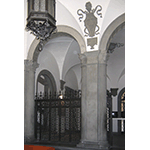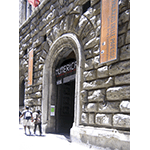Palazzo delle Papesse
The Palace of the Papesses is also known as Palazzo Piccolomini. Formerly headquarters of the Banca d’Italia, a part of the building today houses the Centre of Contemporary Art. According to tradition, its name derives from the two sisters of pope Pius II (Enea Silvio Piccolomini), though it was built by order of only his sister Caterina.
This site has an important historical-scientific significance in relation to the life of Galileo. In 1633, after being condemned by the Tribunal of the Inquisition, the Pisan scientist was consigned to the residence of the ambassador of Tuscany in Rome. He was then permitted to leave the papal city and, as of July 9, was guest of his friend, archbishop Ascanio Piccolomini, in Siena probably at the Palace of the Papesses.
In his work, Monade celeste, o vero trattato di cosmografia, the manuscript of which is today conserved in the Municipal "Intronati" Library of Siena, lecturer of logic and mathematics at the University of Siena Teofilo Gallaccini reports six observations of the moon, made using the telescope from the loggia of the palace in August 1633. Gallaccini reports of how Galileo and those present observed «the lunar body as not having a smooth and uniform body, but is instead similar to the Earth». The episode assumes particular significance precisely because it followed Galileo’s condemnation.
His stay in Siena was also profitable under the profile of physical speculation. As Galileo himself recollects in a letter to Elia Diodati dated March 7, 1634, «in the home of Monsignor the Archbishop […], I wrote a treatise with a new argument, on the subject of mechanics, full of curious and useful speculations». This was the Discorsi e dimostrazioni matematiche intorno a due nuove scienze [Discourses and Mathematical Demonstrations on Two New Sciences], published in Leyden in 1638.
Galileo stayed in Siena until mid December 1633 when he returned to his residence at Arcetri.
****************************
Texts by Graziano Magrini
English translation by Victor Beard
Last update 14/gen/2008





